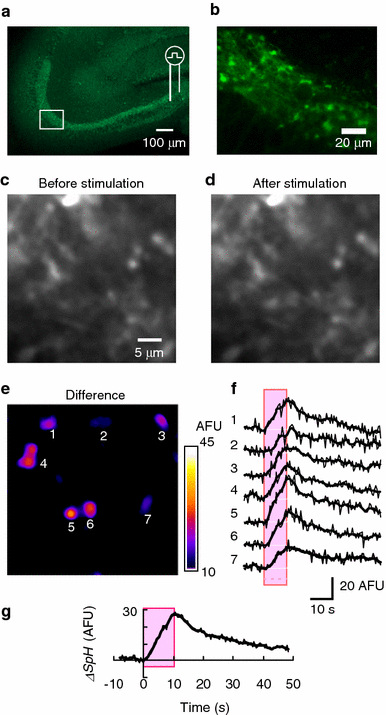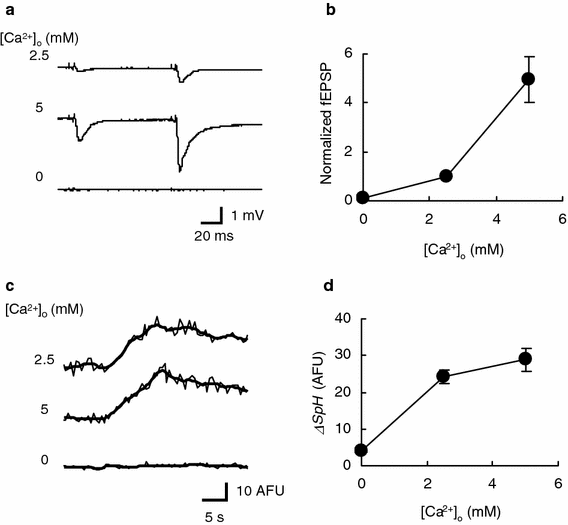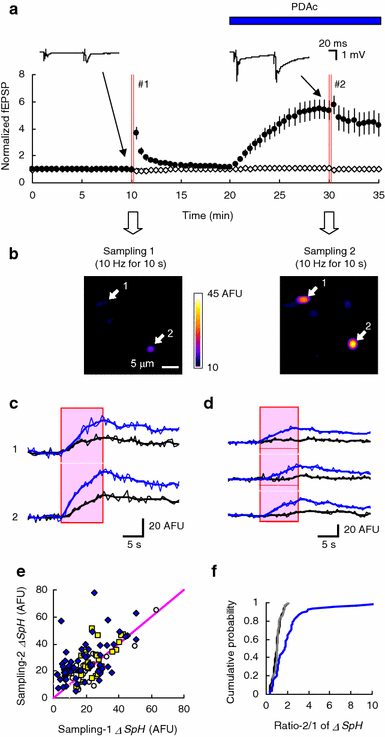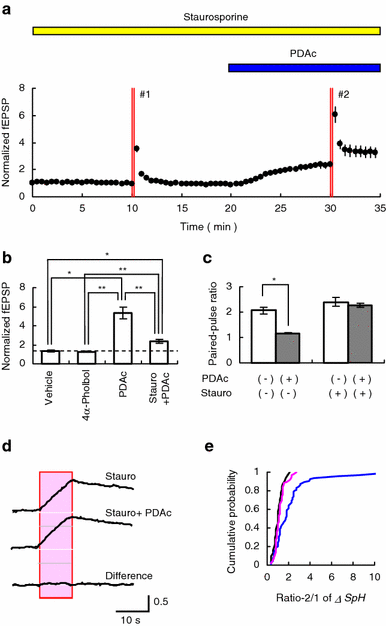beta-Phorbol ester-induced enhancement of exocytosis in large mossy fiber boutons of mouse hippocampus
- PMID: 19340534
- PMCID: PMC10717968
- DOI: 10.1007/s12576-009-0031-0
beta-Phorbol ester-induced enhancement of exocytosis in large mossy fiber boutons of mouse hippocampus
Abstract
beta-Phorbol esters (BPE), synthetic analogues of diacylglycerol (DAG), induce the potentiation of transmission in many kinds of synapses through activating the C(1) domain-containing receptors. However, their effects on synaptic vesicle exocytosis have not yet been investigated. Here, we evaluated the vesicular exocytosis directly from individual large mossy fiber boutons (LMFBs) in hippocampal slices from transgenic mice that selectively express synaptopHluorin (SpH). We found that the activity-dependent increment of SpH fluorescence (DeltaSpH) was enhanced by 4beta-phorbol 12,13-diacetate (PDAc), one of the BPEs, without influencing the recycled component of SpH. These PDAc effects on DeltaSpH were almost completely inhibited by staurosporine, a non-selective antagonist of protein kinases. However, intermittent synaptic transmission was still potentiated through a staurosporine-resistant mechanism. The staurosporine-sensitive cascade may facilitate the vesicle replenishment, thus maintaining the fidelity of transmission at a high level during repetitive firing of the presynaptic neuron.
Figures





Similar articles
-
Synaptic vesicle dynamics in the mossy fiber-CA3 presynaptic terminals of mouse hippocampus.Neurosci Res. 2007 Dec;59(4):481-90. doi: 10.1016/j.neures.2007.08.019. Epub 2007 Sep 12. Neurosci Res. 2007. PMID: 17933408
-
Re-evaluation of phorbol ester-induced potentiation of transmitter release from mossy fibre terminals of the mouse hippocampus.J Physiol. 2000 Dec 15;529 Pt 3(Pt 3):763-76. doi: 10.1111/j.1469-7793.2000.00763.x. J Physiol. 2000. PMID: 11118504 Free PMC article.
-
Assessing the roles of presynaptic ryanodine receptors and adenosine receptors in caffeine-induced enhancement of hippocampal mossy fiber transmission.Neurosci Res. 2011 Oct;71(2):183-7. doi: 10.1016/j.neures.2011.07.001. Epub 2011 Jul 18. Neurosci Res. 2011. PMID: 21782858
-
Remodeling of hippocampal network in pilocarpine-treated mice expressing synaptopHluorin in the mossy fiber terminals.Neurosci Res. 2012 Sep;74(1):25-31. doi: 10.1016/j.neures.2012.07.003. Epub 2012 Jul 16. Neurosci Res. 2012. PMID: 22801461
-
[Presynaptic mechanisms of learning and memory].Brain Nerve. 2008 Jul;60(7):725-36. Brain Nerve. 2008. PMID: 18646612 Review. Japanese.
References
MeSH terms
Substances
LinkOut - more resources
Full Text Sources
Molecular Biology Databases

